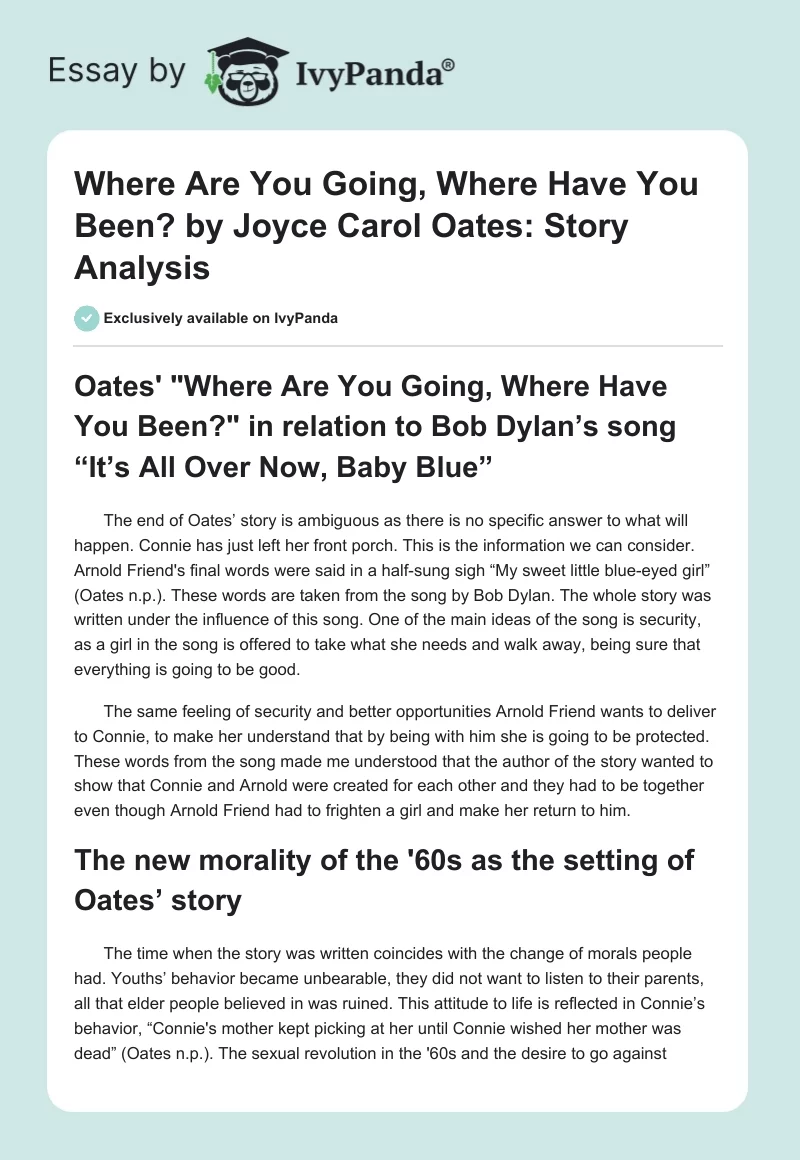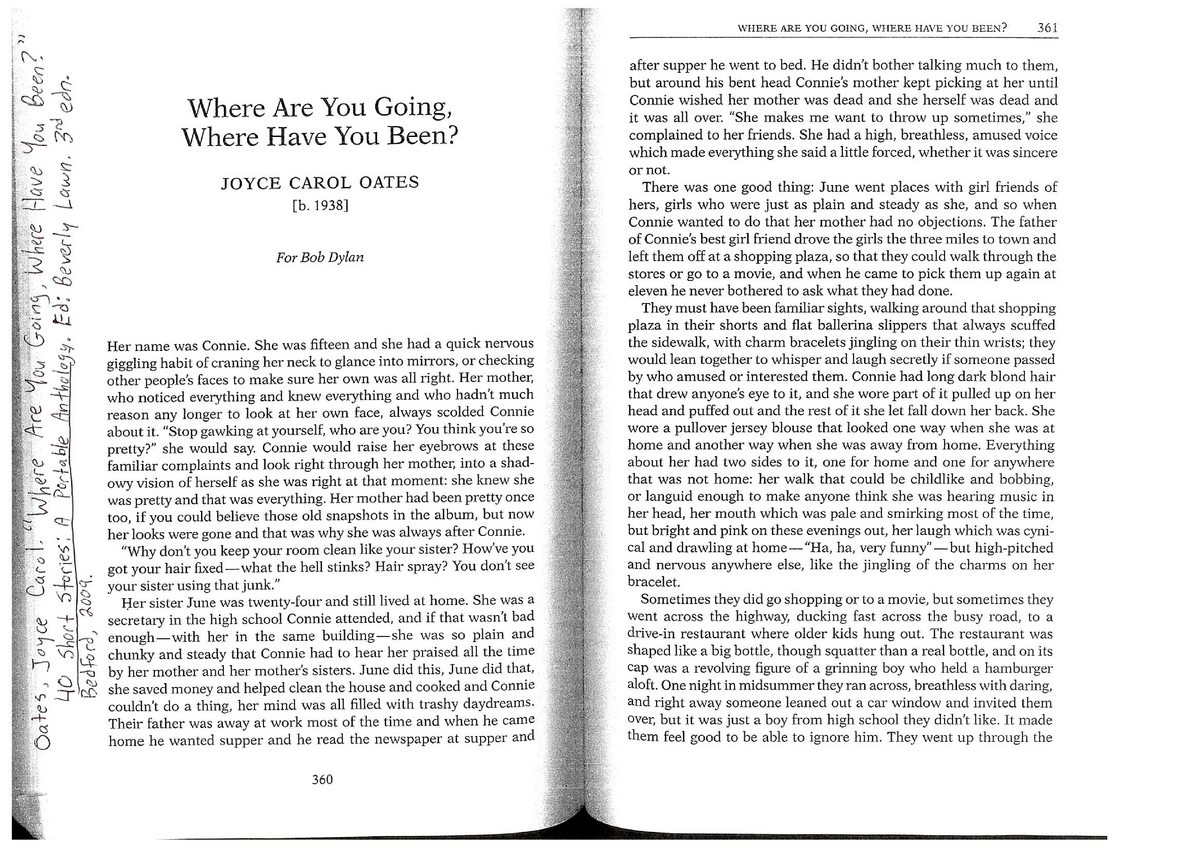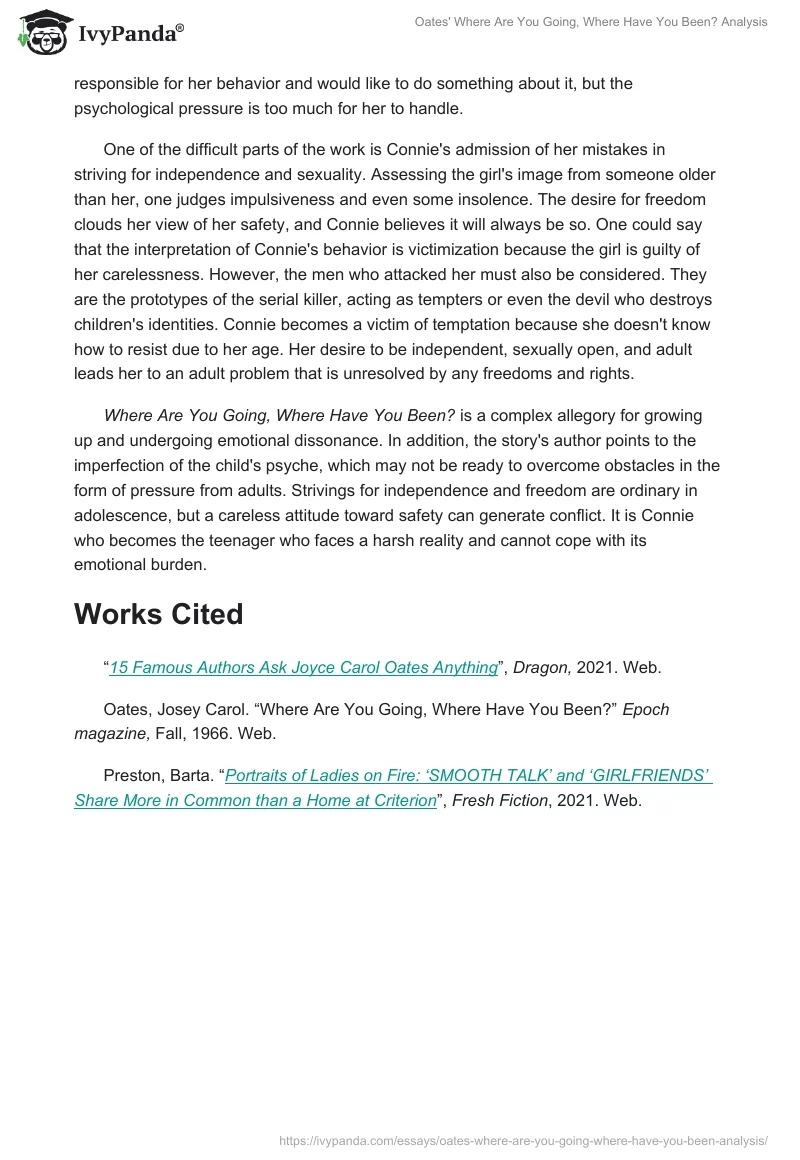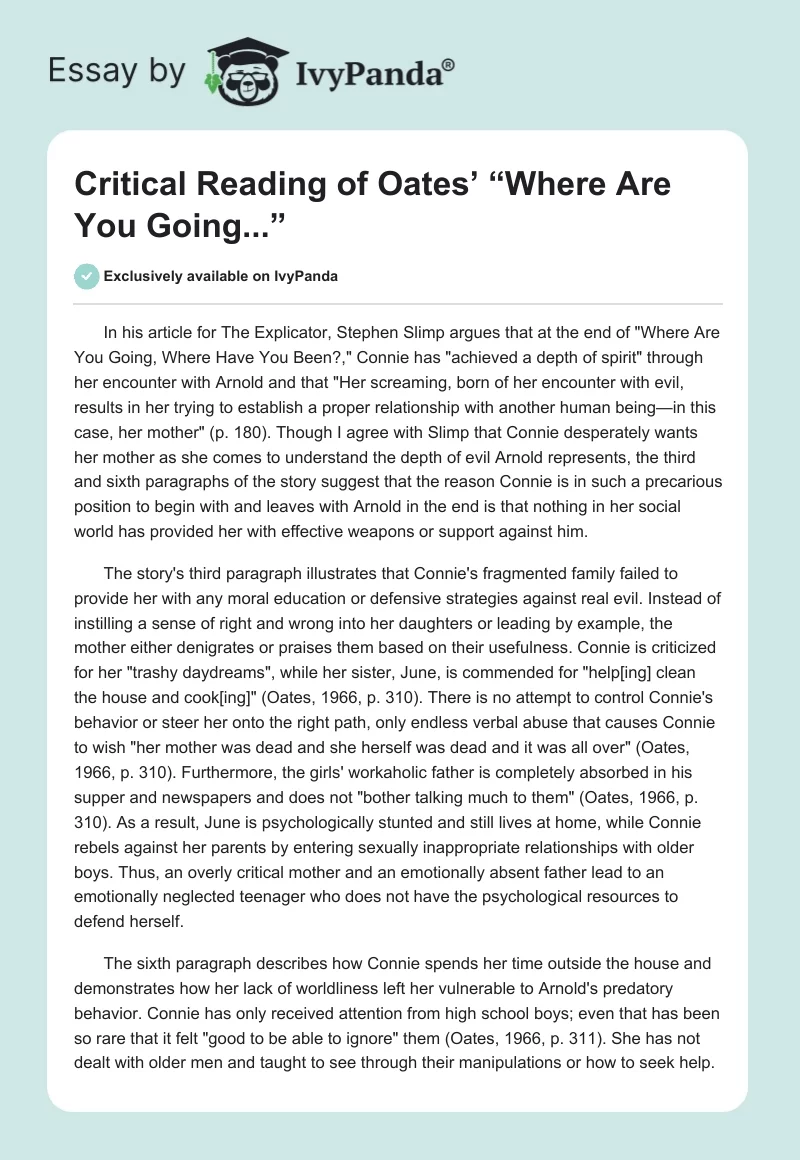
Where Are You Going, Where Have You Been? by Joyce Carol Oates Short Story Summary, Analysis
Summary. Where Are You Going, Where Have You Been? Connie is a fifteen-year-old girl who loves nothing more than spending time with her friends at the plaza and flirting with the boys she meets there. She is frustrated by her family and her life at home, where her mother scolds her for her vanity and continually compares her to her older sister.

Where Are You Going, Where Have You Been? Summary Joyce Carol Oates, Interesting
Start Free Trial. Where Are You Going, Where Have You Been? Summary. "Where Are You Going, Where Have You Been?" is a short story by Joyce Carol Oates in which fifteen-year-old Connie encounters.

Joyce Carol Oates Where Are You Going, Where Have You Been? 1410 Words Essay Example
By Dr Oliver Tearle (Loughborough University) 'Where Are You Going, Where Have You Been?' is a 1966 short story by the American writer Joyce Carol Oates. It is regarded by many critics as Oates' best story, and is widely studied and praised for its treatment of some of the darker aspects of early 1960s America.…

SelfAwareness and Awakening in Raymond Carver's "Cathedral" and Joyce Carol Oates's "Where Are
"Where Are You Going, Where Have You Been?" opens with a physical description of its fifteen-year-old protagonist, Connie —a pretty blonde girl living in 1960s America whose life revolves around bickering with her family, hanging out with her friends, and drooling over boys. Right away, Oates makes clear that Connie is highly conscious of her looks; she has a "habit of craning her neck.

Where Are You Going, Where Have You Been? by Joyce Carol Oates Story Analysis 715 Words
Joyce Carol Oates answers the frequently asked question about her most famous story: why did you dedicate "Where Are You Going, Where Have You Been?" to Bob.

MINISODE 9 Where Are You Going? Where Have You Been? by Joyce Carol Oates Audible
James's The Turn of the Screw, in its portrayal of a governess who is pursued by a possibly supernatural entity, is especially relevant to Oates's work. The fiction of Flannery O'Connor, which tackles the nightmarish aspect of American culture, has also been hugely influential for Oates.

Where Are You Going Oates ENGL 100 Studocu
One night, a boy named Eddie invites Connie to eat dinner with him, and Connie leaves her friend at the restaurant's counter to go with him. As they walk through the parking lot, she sees a man in a gold convertible. He smiles at her and says, "Gonna get you, baby.". Connie hurries away, and Eddie notices nothing.

Oates' "Where Are You Going, Where Have You Been?" 647 Words Research Paper Example
The opening line of Joyce Carol Oates's frequently anthologized 1966 masterpiece of short fiction "Where Are You Going, Where Have You Been?" immediately draws the reader into the past: "Her name was Connie" (25). Of course, the title of the work mentions the past also—"Where Have You Been?" Seemingly, then, the past, or at least some recognition of past actions, past times.

⇉Oates' Where Are You Going, Where Have You Been? Essay Example GraduateWay
"Where Are You Going, Where Have You Been?" is a frequently anthologized short story written by Joyce Carol Oates.The story first appeared in the Fall 1966 edition of Epoch magazine. It was inspired by three Tucson, Arizona murders committed by Charles Schmid, which were profiled in Life magazine in an article written by Don Moser on March 4, 1966. Oates said that she dedicated the story to.

'Where Are You Going, Where Have You Been?' Joyce Carol Oates by Joyce Carol Oates
Overview. Joyce Carol Oates 's 1966 short story "Where Are You Going, Where Have You Been?" tells the story of a teenage girl named Connie who is confronted by a mysterious man named Arnold Friend while her family is away from home. The story was inspired by the real-life serial killer Charles Schmid, who preyed on young women in Tucson.

Where Are You Going? [1986] heavenfile
Despite Vic seemingly willingly going to the room with said girl, it is obvious that what he experienced with her will likely haunt him for the rest of his life. On the other hand, in the short story "Where Are You Going, Where Have You Been" the author, Carol Oates, does not directly display Connie's reflection on what she experienced or trauma.

"Where Are You Going, Where Have You Been?" by Joyce Carol Oates 551 Words Research Paper
Joyce Carol Oates dedicated this story to Bob Dylan, and she explained her reasoning in the May 19, 2015, edition of The Wall Street Journal:. The beauty of the song ["It's All Over Now, Baby.

Critically Reading Oates' "Where Are You Going..." 802 Words Critical Writing Example
Where Are You Going, Where Have You Been? by Joyce Carol Oats. for Bob Dylan. Her name was Connie. She was fifteen and she had a quick, nervous giggling habit of craning her neck to glance into mirrors or checking other people's faces to make sure her own was all right. Her mother, who noticed everything and knew everything and who hadn't much.

Joyce Carol Oates Where Are You Going, Where Have You Been? Joyce carol oates, Classic short
Analysis of Joyce Carol Oates's Where Are You Going, Where Have You Been? By NASRULLAH MAMBROL on April 26, 2022. Probably the most gifted—and certainly the most prolific—literary talent of the second half of the 20th century, Joyce Carol Oates continues to be prolific into the 21st century. She has published more than 50 books; won the National Book Award for Them, her novel published.

Where Are You Going Where Have You Been Joyce Carol Oates Quotes Quotes About Life
is a modern classic by Joyce Carol Oates. Oates draws on mythology, music, and modern culture in order to create her story. Here is a summary, analysis and breakdown of some of the sources and inspiration she used, along with an interpretation of their meaning. Joyce Carol Oates' story is about a young girl at the edge of adulthood.

Where Are You Going, Where Have You Been by Oates YouTube
Interest in equal rights for women was a subject of great controversy during the early years of Oates's career leading up to "Where Are You Going, Where Have You Been?" The 1960s and early 1970s.
